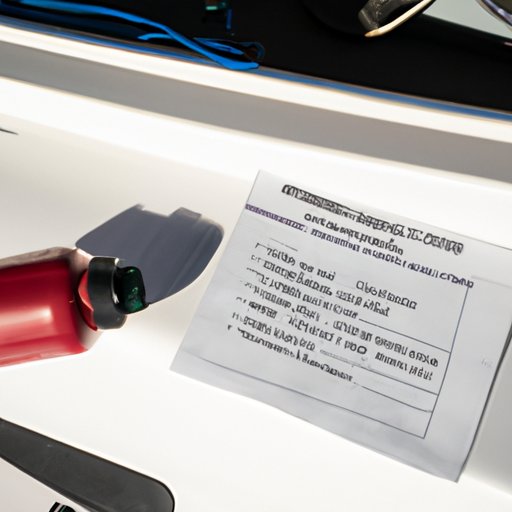
Introduction
As boat owners know, winter weather can be harsh on watercraft, causing potential damage if not properly prepared. To avoid costly repairs and ensure your boat stays in excellent condition, it’s essential to winterize it. This process involves protecting your boat’s engine, plumbing, and other systems and storing it safely and securely. This guide will provide a comprehensive breakdown of the steps involved in winterizing a boat, as well as expert tips and recommendations to ensure your vessel stays in top shape.
Winterization steps for the entire boat
The first step in winterizing a boat is to prepare the entire vessel. This includes the engine, batteries, plumbing, and fuel system. Here are some essential steps to take:
Engine
Start by changing the oil and filter to remove any contaminants from the engine. Next, flush the cooling system with fresh water. Finally, add antifreeze to the cooling system and run the engine for several minutes to ensure the antifreeze circulates throughout the system.
Batteries
Remove the batteries from the boat and store them in a warm, dry place. Before storing them, make sure they are fully charged and disconnected from the boat’s electrical system.
Plumbing
Drain all water from the system, including freshwater and wastewater tanks. Once drained, add antifreeze to the system to prevent any remaining water from freezing.
Fuel system
Stabilize the fuel by adding a fuel treatment product, which will prevent sediment buildup and maintain fuel quality during winter storage.
Checklist of items to accomplish before winter
Before storing your boat for the winter, there are a few essential items to check off your list. Doing so will give you peace of mind and ensure your boat is in top shape when it’s time to use it again. Here are some items to include on your checklist:
Checking antifreeze concentration levels
Make sure the antifreeze concentration levels used in the engine and plumbing systems are optimal to prevent freezing. Most marine mechanics recommend a 50/50 ratio of antifreeze to water.
Inspecting the hull for cracks or leaks
Check your boat’s hull for any visible cracks or leaks. If you find any cracks or leaks, seal them immediately to avoid further damage.
Draining and cleaning the boat
Degrease the engine, clean the boat’s exterior, and drain any remaining water from the bilge. Removing any debris and dirt will protect your boat’s surfaces and ensure its longevity.
Guide to properly shrink-wrapping a boat
Shrink-wrapping a boat is an effective way to protect it from harsh winter weather conditions, such as snow, wind, and rain. Here’s a guide to doing it correctly:
Different types of shrink-wrap covers
Select the right shrink-wrap cover for your boat. Some factors to consider include size, thickness, and color.
Measuring, cutting, and sealing the cover
Measure your boat and cut the shrink-wrap to fit snugly. Seal the cover by using heat to create a tight seal.
Tips for ensuring a secure fit
Ensure the shrink-wrap cover is secured tightly to the boat by placing straps over the cover or securing it with duct tape. This step will ensure the cover remains in place throughout the winter season.
Importance of properly storing and maintaining equipment
Properly storing and maintaining your boat’s equipment is essential to keep them in good condition. Here are some tips to help you:
Life jackets, ropes, and other boating equipment
Clean boating equipment, such as life jackets and ropes, and store them in a dry place. Doing so will ensure they remain in good condition and are ready to use when needed.
Tips for storing and cleaning
Use a marine-specific cleaner to clean your equipment properly. Also, avoid exposing your equipment to direct sunlight or harsh weather conditions.
Shortlist of recommended boat storage facilities
Choosing the right storage facility for your boat is crucial, as it can determine its longevity and safety. Here are some recommended boat storage options to consider:
Different facilities for different types of boats
Choose a storage facility that suits your boat size, type, and location. Additionally, look for facilities that provide proper weather protection, such as indoor storage options for added security.
Explanation of why each option may be the best choice
Consider the cost, location, features, and availability of each storage option before making a decision.
Expert tips for winterizing boats
To get the best advice for winterizing your boat, we spoke to several marine mechanics and boat dealerships. Here are some expert tips we gathered:
Interview with marine mechanics and boat dealerships
Consult a marine mechanic or dealership before winterizing your boat. They can offer helpful tips and advice based on your boat’s specific needs.
Professional advice and tips
Consider investing in a comprehensive winterization package. This option provides a complete winterization service, which will ensure your boat is protected and ready for use when spring arrives.
Potential damage from improper winterization
Failing to winterize your boat correctly can cause significant damage, such as:
Mold growth
Moisture buildup in your boat can lead to mold and mildew growth, which can damage your boat’s interior and create health hazards.
Engine corrosion
Water left in your engine or fuel system can cause corrosion, leading to costly repairs or needing to replace the entire system.
Other potential scenarios
Damaged plumbing from frozen water, frozen fuel lines or filters, and a weakened hull can also result in severe damage.
Conclusion
Winterizing your boat is essential to protect it from harsh winter conditions and ensure its longevity. Taking necessary precautions such as changing your boat’s oil, adding antifreeze, and storing it in a safe place is crucial. Following this comprehensive guide and expert tips will ensure your boat remains in excellent condition and is ready for use when spring arrives.




